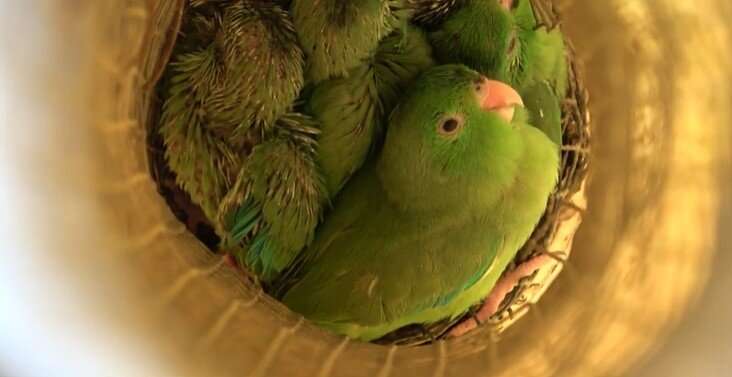Credit: Proceedings of the Royal Society B: Biological Sciences (2022). DOI: 10.1098/rspb.2022.0592
A team of researchers from the University of Texas Rio Grande Valley, working with colleagues from several research facilities in Venezuela, has found evidence of babbling in wild baby parrots. In their paper published in Proceedings of the Royal Society B, the group describes the unique vocalizations of the baby birds, similar to human infants, and what they learned about the role of stress hormones in the development of their communication skills.
Human beings have known for thousands of years that parrots have extraordinary vocal abilities—not only do they communicate well, but they can imitate other species including humans. But in all that time, the babbling of baby parrots has gone unobserved. The researchers suggest that this is because they live inside holes in trees where no one but their parents and siblings can hear them.
The researchers discovered the babbling almost by accident. They were working as part of a team on a long-term field study involving parrots at the Masaguaral Biological Station in Venezuela. More than 10,000 green-rumped parrots there have been under study since 1988. As part of that effort, researchers have used PVC pipes to build nests for the tiny birds, and added tiny audio/video recording devices.
Credit: Proceedings of the Royal Society B: Biological Sciences (2022). DOI: 10.1098/rspb.2022.0592
In listening to the birds in their nests, the researchers found that the baby parrots tended to babble a lot—mostly when alone or when their siblings were sleeping. They noted that a lot of the noises they made were random, while some noises were copied from their parents or other animals in the area. They also found the babbling tended to start when they reached 21 days old.
Noting that prior research has shown that stress hormones in human infants accelerate the development of communication skills, they fed one small group of the baby parrots a tiny amount of corticosterone and then compared their babbling with others their age. This cohort began to babble approximately twice as much as they normally would. They suggest their findings indicate that stress hormones have a big impact on the parts of the brain associated with learning to communicate.
More information: Rory Eggleston et al, Vocal babbling in a wild parrot shows life history and endocrine affinities with human infants, Proceedings of the Royal Society B: Biological Sciences (2022). DOI: 10.1098/rspb.2022.0592
Journal information: Proceedings of the Royal Society B
© 2022 Science X Network
























